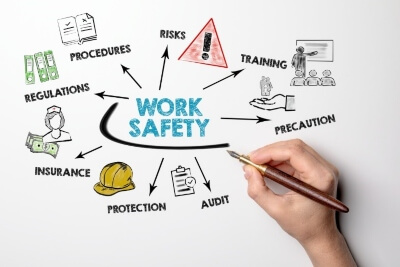When someone mentions the term “Distracted Driving” to me, I think – so what? That’s nothing new.
I remember when it hit the news that the Highway Traffic Act was being amended, it caused quite the stir.
I was reading all over social media, we could now get tickets for drinking coffee, eating a breakfast sandwich, etc. However, as I am sure you are all aware that none of that came to pass.
Yes, they banned the use of electronics, but really nothing much else changed.
Well, perhaps there was an uptick in the sales of Bluetooth headsets. So when I was assigned the topic of “Distracted Driving” as a blog post recently, I was a bit thrown off.
THIS IS NOTHING NEW.
However, as it turns out, there was a reason or five (specifically) – it had been brought up in our JHSC meetings.

Now besides being a trainer and an HR professional, I am also human. I obviously had my curiosity piqued with the prospect of some juicy office gossip of a co-worker being silly enough to get caught by the police or even a member of the public chatting on the phone while driving a company car.
Have you seen our driving billboards? Loud and proud is an apt description.
So I call my manager to discuss the contents of my assignment, and I was hit with a bit of a shock.
It wasn’t one of our employees falling afoul of the Highway Traffic Act (Surprised? We are a safety company after all…), but a participant.
With the pandemic past the one-year mark, most of us are used to a more digital interaction with others outside our households, as for training, that hasn’t been an exception either.
Yes, we still offer in-person training with Covid-19 protocols in place – but as a distance learning trainer, I can tell you remote learning has taken off!
The vast majority of days, I am working from home and not in your facility like in the past.
Not going to lie; as an introvert, I love it.
That being said, my point is digital interaction with others is nothing new but herein lays the hazard.
Anyone see where this is going? Yep, complacency.
In April, we posted a blog highlighting “The Four Stages of Competence”, and if you take a quick gander at that, you will see how it is not only easy to get complacent, but it is a natural progression – our brains try to be lazy… Errr… I mean efficient.
Nevertheless, I am sure you are aware that complacency kills.
You may be asking, alright, I get it – don’t drive and talk on a zoom meeting; what’s your point here? And the point I am trying to make is how easy we as individuals make these mistakes.
I am sure that participants didn’t book a distance learning course to drive around town while meeting their employer’s training requirements.
I think the situation arose because they just didn’t see it as a big deal – and in safety – it’s enormous.
If you have been reading these posts for any length of time, you know we will start now with legislation/regulation. Let’s see what the rules are, so we know our limit and play within it.
Ontario Regulation 366
Ontario Regulation 366 is appropriately titled Display Screens and Hand-Held Devices. If you pull it up on e-laws and scroll down to S.7, you will see a list of exempt devices.
It reads, “The display screens of the following devices may be visible to any driver in a motor vehicle driven on a highway:
- A device that displays,
- information on the conditions, use and immediate environment of the vehicle, or
- information on road or weather conditions.
- An ignition interlock device.
- A car audio control that displays only text or static images.
- A hand-held device that displays only text or static images and is connected directly into and operates using the audio system controls of the motor vehicle.”
So it tells us what we can, and more importantly in this situation, cannot have in front of us while driving.
In that list, I see GPS, interlock devices (don’t drink and drive, FYI), car radios, and your music storage device (I was going to say mp3 player but realized I was going to date myself, lol).
What it happens to omit is your hand-held device displaying your occupational health and safety course via Zoom/Teams/GoToMeeting/WebEx etc.
Now I am most certainly not a lawyer but any means, but I’m pretty sure it is safe to say that what that participant did was illegal. As a safety company, that type of activity is not condoned or permitted, and the trainer I was told handled it quite well.
After the occurrence, a new hazard was identified, and of course, the RACE methodology kicked in, and the hazard was controlled administratively – or so we thought.
Since that initial event, we have had FIVE, that’s right, FIVE more of the exact same thing. Most recently, I was witness to it just last week.
After clearly informing the participants of the set expectations and rules for participating, including explicitly highlighting distracted driving – a worker popped in their vehicle and hit the road. FYI you know you guys are on camera, right?
But it again begs the question, why?
As residents of Ontario, we know what is allowed on the roads, and participants in courses know what behaviour is required – yet it still has become a safety issue.
At the heart of it, we have become too comfortable, too complacent with our controls. To be honest, how many of you forget your camera is on in video calls? (Yes, we have witnessed more than intended…)
How many of us drive on the road and see a text and, out of pure habit, grab that phone? Same logic as when we watch a worker pick up a box with their back instead of using proper lifting techniques, all examples are in the 4th stage of competence.
It doesn’t change the employer’s obligation to provide a safe workplace, however.
7 Types of Rest
Recently I was listening to CBC Radio 1 while driving to the office for an essential purpose, and I heard a workplace expert talk about the 7 types of rest we need as humans.
One issue that was brought up was associated with working from home. The phrase they used was along the lines of “we no longer find ourselves working from home, but living at work.”
And that, my friends, is precisely what I think was a major contributing factor/immediate cause to the incident that triggered this post.
The individuals involved have meshed their professional and work lives for so long that the borders have become hazy. In their personal lives, they may very well be okay with violating the distracted driving law.
They are used to taking breaks outside their normal assigned schedule and making up the time with flex hours. For them, going back to a regimented schedule was something they had not been prepared (both mentally and physically – please wear pants while taking courses online – for that last time) to do.
Where does this leave us, though? We have pointed out a newly discovered workplace hazard and discussed its contributing factors.
The solution, though, lies with your organization.
As trainers, we explain the rules to participants, and those who violate them are removed from the session. But what rules, what code of conduct, what set expectations have been formalized in your workplace?
Have you actually incorporated distracted driving into your policy – defaulting to the law isn’t sufficient, as I am sure you are aware?
If you already have done so, excellent! But have you updated it to include working from home and or digital meetings? If so, excellent again!
Now, I mentioned the RACE methodology above, and the last stage is evaluation. If your organization has addressed all of my concerns, I have one last question: are you ensuring compliance?
Having controls in place, here at IST, we are using an administrative mechanism, is a start. But I am sure our participant’s management team is unaware of their actions, as I’m sure it would be frowned upon.
There is an onus on the employer to enforce zero-tolerance policies regarding cell phones in the workplace. Have any of you read the February 2019 edition of Canadian Occupational Health and Safety Magazine? Who am I kidding? I know you did.
In any case, I’ll just give a little reminder since it’s probably been a while. The article was titled “Forklift drivers convicted for cellphone use in the warehouse.”
The short version of the story is that two workers were on their cellphones while having access to a forklift, and no, not even driving it. A work refusal led to an MLTSD investigation, and ultimately, charges.
In this case, the employer’s commitment to worker safety and enforcement of zero-tolerance policies regarding cell phones shielded them from the burdens of prosecution. The Inspector laid their charges against the workers under OHSA S. 28(2)(b) “No worker shall use or operate any equipment, machine, device or thing or work in a manner that may endanger himself, herself or any other worker.”
What was heard by the courts was that at that facility, their workers knew better – but what about at yours? Will I see your colleagues in my next course behind the wheel?
Well, I guess time will tell if you get the juicy office gossip I did not.
Make good choices.
Geoff Rowatt | CHRL
Safety Trainer,
Industrial Safety Trainers Inc.





